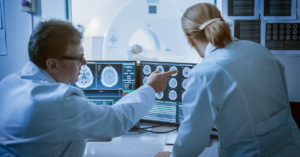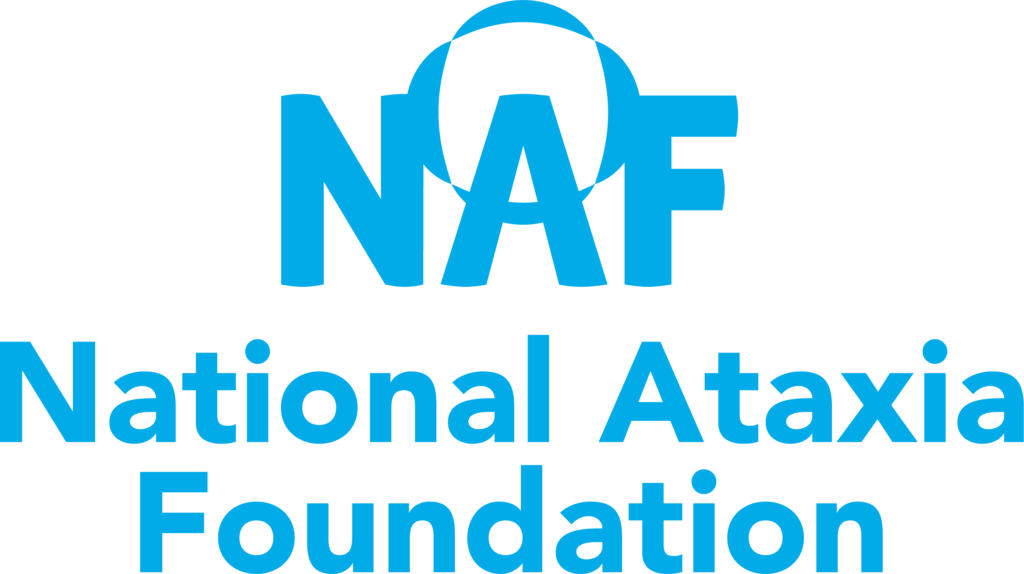
Written by Marija Cvetanovic, PhD
Edited by Spyros Petrakis, PhD
Researchers from Yale provide evidence that glial cells, in particular Bergmann glia in the cerebellum, may contribute to disease pathogenesis in SCA1.
The human brain contains approximately 170 billion cells. However, approximately half of them (86 billion cells) are not neurons. Most of these non-neuronal cells are called glia, a term encompassing: a) astrocytes, star shaped glia that support and regulate neurons, b) microglia, that protect brain against infection and remove dead cells, and c) oligodendrocytes, that produce a myelin sheet which helps neurons to communicate faster. Cerebellum is a brain region with severe pathology in spinocerebellar ataxias (SCAs) and contains a special type of astrocytes called Bergmann glia. Bergmann glia (BG) reside next to Purkinje cells (PC), a type of neurons that are important for movement and balance and are lost in SCAs. BG are essential for the proper function of PC, and dysfunction of BG can lead to PC loss and movement deficits.
In disease, astrocytes undergo a change in their shape and function, that can either be beneficial or harmful. Spinocerebellar ataxia type 1 (SCA1) is a dominantly inherited neurodegenerative disease caused by the expansion of CAG trinucleotide repeats in the gene Ataxin1 (ATXN1). These repeats encode for longer glutamine (polyglutamine, polyQ) tracts in the ATXN1 protein. Patients with SCA1 suffer from progressive motor and balance deficits, and severe loss of PC in the cerebellum. There is also evidence that BG change their shape in the brain of SCA1 patients.
To investigate whether BG actually contribute to SCA1 disease onset and progression, researchers use mouse models of SCA1. One of the best-characterized mouse models of SCA1 is the ATXN1[82Q] line created by Dr. Harry Orr at the University of Minnesota. In these mice, mutant ATXN1 with 82 CAG repeats is expressed only in the PC. ATXN1[82Q] mice demonstrate shrinking and eventual loss of PC, movement and balance deficits and changes in BG, as seen in SCA1 patents. Previous studies found that BG are helpful at early stages of the disease, but become harmful at late stages of SCA1. In particular, preventing BG changes early in disease exacerbates movement and balance problems in mice and worsens PC pathology. The opposite is observed when BG changes are modulated at a later stage, an event that ameliorates motor deficits and PC pathology. It remains unknown what causes Bergmann glia to change shape and act either in a beneficial or a harmful manner in SCA1.
In this study, Luttik et al. found that mutant ATXN1 activates a particular signaling pathway, called Wnt signaling, throughout the cerebellum in late stages of the disease and in two different SCA1 mouse models. The Wnt signaling pathway plays an important role during development and is also involved in various pathologies, including cancers of breast colon and skin. Its name (Wnt) is a fusion of the gene name wingless in the fruit fly and its vertebrate homolog, integrated or int-1. Wnt binds to a receptor molecule at the surface of cells and causes changes through three different pathways, one that requires the protein called β-catenin, another one that involves the Planar Cell Polarity protein and a third one that changes the levels of calcium. Wnt/β-catenin pathways regulate the movement of β-catenin into the nucleus, where it binds the proteins TCF/LEF and increases gene expression. Using cultures of immortalized HeLa cells, Luttik et al. found that mutant ATXN1 binds directly to TCF proteins and further increases gene expression by Wnt.
Then, authors asked what would happen if they could mitigate Wnt signaling and β-catenin pathways in SCA1 mice. Would this be beneficial, reducing PC pathology and motor deficits or harmful, worsening SCA1 symptoms? What would happen if they would increase Wnt signaling in healthy mice? Would this cause SCA1 symptoms?
Authors first increased or decreased Wnt signaling in PCs. Reducing Wnt signaling in PCs did not ameliorate pathology in SCA1 mice. Also, increasing Wnt signaling in PCs of healthy mice did not cause pathology either. Based on these observations, authors concluded that modifications of Wnt signaling in PC does not seem to play an important role in SCA1. However, authors observed an increase in Wnt signaling in BG which are important for the function of PC. Therefore, they performed similar experiments in BG of healthy and SCA1 mice. They found that increasing Wnt/β-catenin in BG of healthy mice, causes changes in the shape and number of BG, as also observed in SCA1. These exciting results indicated that Wnt/β-catenin signaling may affect BG in SCA1.
Next, authors asked a key question: would reduction of Wnt/β-catenin signaling in BG ameliorate SCA1 pathology? Unfortunately, SCA1 pathology was not rescued by a 50% decrease in Wnt signaling throughout the body. It is possible that a larger reduction in Wnt signaling is needed to rescue SCA1 pathology. Alternatively, other signaling pathways that are changed in SCA1 may compensate the suppression of Wnt signaling and are sufficient to cause SCA1 pathology.
In summary, this study further supports the importance of BG in SCA1 progression and indicates that Wnt signaling contributes to BG changes in late stages of the disease. The exact role of Wnt signaling in SCA1 remains to be determined in future studies.
Conflict of Interest Statement
The author and editor have no conflicts of interest to declare.
Citation of Article Reviewed
Luttik K, Tejwani L, Ju H, Driessen T, Smeets CJ, Edamakanti CR, Khan A, Yun J, Opal P, Lim J. Differential effects of Wnt-β-catenin signaling in Purkinje cells and Bergmann glia in spinocerebellar ataxia type 1. Proceedings of the National Academy of Sciences. 2022 Aug 23;119(34):e2208513119.
Read Other SCAsource Summary Articles

SCAview: Grandes datos para grandes preguntas
Escrito por Dr. Celeste Suart Editado por Priscila Pereira Sena Traducido por Ismael Araujo Aliaga Un grupo internacional de investigadores desarrolló una novedosa herramienta para visualizar grandes bases de datos de información Read More…

Alternative splicing: Potential disease mechanism for SCA1
Written by Christina PengEdited by Larissa Nitschke, PhD Ever since the CAG expansion of the Ataxin-1 (ATXN1) gene has been identified as the cause of spinocerebellar ataxia type 1 (SCA1), Read More…

Spotlight on Glia in Spinocerebellar Ataxia Type 1
Written by Marija Cvetanovic, PhDEdited by Spyros Petrakis, PhD Researchers from Yale provide evidence that glial cells, in particular Bergmann glia in the cerebellum, may contribute to disease pathogenesis in Read More…










